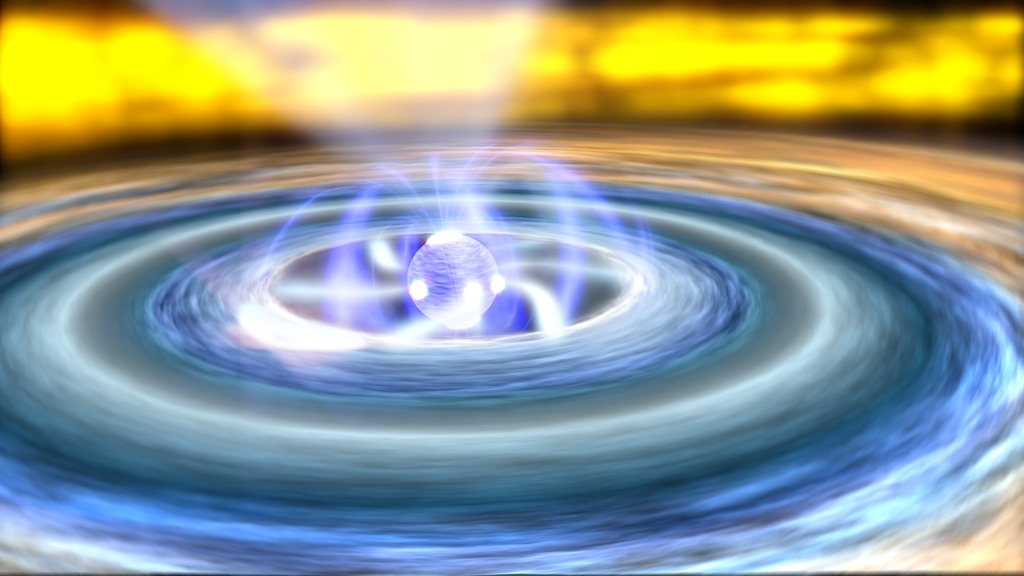NICER Catches Milestone X-ray Burst
At about 10:04 p.m. EDT on Aug. 20, NASA’s Neutron star Interior Composition Explorer (NICER) telescope on the International Space Station detected a sudden spike of X-rays caused by a massive thermonuclear flash on the surface of a pulsar, the crushed remains of a star that long ago exploded as a supernova.
The X-ray burst, the brightest seen by NICER so far, came from an object named SAX J1808.4-3658, or J1808 for short. The observations reveal many phenomena that have never been seen together in a single burst. In addition, the subsiding fireball briefly brightened again for reasons astronomers cannot yet explain.
The data reveal a two-step change in brightness, which scientists think is caused by the ejection of separate layers from the pulsar surface, and other features that will help them decode the physics of these powerful events.
The explosion, which astronomers classify as a Type I X-ray burst, released as much energy in 20 seconds as the Sun does in nearly 10 days.
J1808 is located about 11,000 light-years away in the constellation Sagittarius, spins at a dizzying 401 rotations each second, and is one member of a binary system. Its companion is a brown dwarf, an object larger than a giant planet yet too small to be a star. A steady stream of hydrogen gas flows from the companion toward the neutron star, and it accumulates in a vast storage structure called an accretion disk.
Hydrogen raining onto the pulsar's surface forms a hot, ever-deepening global “sea.” At the base of this layer, temperatures and pressures increase until hydrogen nuclei fuse to form helium nuclei, which produces energy — a process at work in the core of our Sun.
The helium settles out and builds up a layer of its own. Eventually, the conditions allow helium nuclei to fuse into carbon. The helium erupts explosively and unleashes a thermonuclear fireball across the entire pulsar surface.
As the burst started, NICER data show that its X-ray brightness leveled off for almost a second before increasing again at a slower pace. The researchers interpret this “stall” as the moment when the energy of the blast built up enough to blow the pulsar’s hydrogen layer into space.
The fireball continued to build for another two seconds and then reached its peak, blowing off the more massive helium layer. The helium expanded faster, overtook the hydrogen layer before it could dissipate, and then slowed, stopped and settled back down onto the pulsar’s surface. Following this phase, the pulsar briefly brightened again by roughly 20 percent for reasons the team does not yet understand.
A thermonuclear blast on a pulsar called J1808 resulted in the brightest burst of X-rays seen to date by NASA’s Neutron star Interior Composition Explorer (NICER) telescope. The explosion occurred on Aug. 20, 2019, and released as much energy in 20 seconds as our Sun does in almost 10 days. Watch to see how scientists think this incredible explosion occurred.
Credit: NASA's Goddard Space Flight Center
Music: "Business As Usual" from Universal Production Music
Complete transcript available.
Watch this video on the NASA Goddard YouTube channel.
Illustration depicting a Type I X-ray burst. The explosion first blows off the hydrogen layer, which expands and ultimately dissipates. Then rising radiation builds to the point where it blows off the helium layer, which overtakes the expanding hydrogen. Some of the X-rays emitted in the blast scatter off of the accretion disk. The fireball then quickly cools, and the helium settles back onto the surface.
Credit: NASA's Goddard Space Flight Center/Chris Smith (USRA)
Illustration depicting the SAX J1808.4-3658 system, a pulsar and its orbital companion, a brown dwarf.
Credit: NASA's Goddard Space Flight Center/Chris Smith (USRA)
Illustration of the accreting pulsar J1808.
Credit: NASA's Goddard Space Flight Center/Chris Smith (USRA)
An alternative wide shot of the J1808 binary system.
Credit: NASA's Goddard Space Flight Center/Chris Smith (USRA)
Illustration showing the pulsar's magnetic field sweeping up hydrogen gas from the accretion disk and channeling it to the pulsar's surface.
Two versions are available: One with elements of the illustration dimmed to emphasize the gas flow, and one without dimming.
Credit: NASA's Goddard Space Flight Center/Chris Smith (USRA)
Hydrogen raining onto the pulsar's surface forms a hot, ever-deepening global “sea.” At the base of this layer, temperatures and pressures increase until hydrogen nuclei fuse to form helium nuclei, which produces energy — a process at work in the core of our Sun.
Versions are available with and without labels.
Credit: NASA's Goddard Space Flight Center/Chris Smith (USRA)
NICER data trace the changing X-ray intensity of the 20-second-long burst, revealing key details.
Credit: NASA's Goddard Space Flight Center

Looping GIF illustration of the X-ray burst.
Credit: NASA's Goddard Space Flight Center/Chris Smith (USRA)

Looping GIF illustration of the J1808 binary system.
Credit: NASA's Goddard Space Flight Center/Chris Smith (USRA)

Looping GIF illustration of the J1808 pulsar.
Credit: NASA's Goddard Space Flight Center/Chris Smith (USRA)
For More Information
Credits
Please give credit for this item to:
NASA's Goddard Space Flight Center. However, individual items should be credited as indicated above.
-
Producer
- Chris Smith (USRA)
-
Science writer
- Francis Reddy (University of Maryland College Park)
-
Animators
- Chris Smith (USRA)
- Walt Feimer (KBR Wyle Services, LLC)
Release date
This page was originally published on Thursday, November 7, 2019.
This page was last updated on Wednesday, May 3, 2023 at 1:45 PM EDT.
